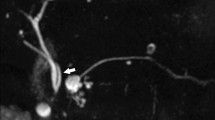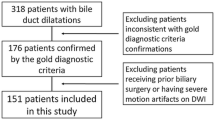Abstract
Background
We assessed the role of mangafodipir-enhanced magnetic resonance (MR) cholangiography in the detection and location of bile duct leaks after laparoscopic cholecystectomy.
Methods
In a prospective study, 34 patients with clinical suspicion of bile duct leak after laparoscopic cholecystectomy underwent MR imaging. Our protocol included conventional heavily T2-weighted MR cholangiography and three-dimensional T1-weighted MR cholangiography after an intravenous bolus injection of mangafodipir trisodium. All studies were performed on a 1.5-T or 1-T scanner. Contrast-enhanced MR cholangiograms were evaluated for the presence and location of bile duct leaks. Correlation was obtained in all cases with surgery (n = 15), endoscopic retrograde cholangiography (n = 5), percutaneous drainage (n = 5), and clinical follow-up (n = 9).
Results
In 20 of 34 patients, bile duct leakage was proved by surgery, endoscopic retrograde cholangiography, or drainage. Contrast enhancement displayed the leakage in 19 of 20 patients and ruled out leaks in the other 14 patients (95% sensitivity, 100% specificity). The leak site was depicted in 14 patients and contrast-enhanced MR cholangiography successfully located the origin of the leak in 11 patients.
Conclusions
Contrast-enhanced MR cholangiography with intravenous mangafodipir trisodium can accurately diagnose the presence and location of bile duct leaks in patients who have undergone laparoscopic cholecystectomy.









Similar content being viewed by others
References
I Braghetto J Bastias A Csendes A Debandi (2000) ArticleTitleIntraperitoneal bile collections after laparoscopic cholecystectomy: causes, clinical presentation, diagnosis and treatment Surg Endosc 14 1037–1041 Occurrence Handle10.1007/s004649900029 Occurrence Handle11116414
BV MacFadyen R Vecchio AE Ricardo CR Mathis (1998) ArticleTitleBile duct injury after laparoscopic cholecystectomy—the United States experience Surg Endosc 12 315–321 Occurrence Handle10.1007/s004649900661 Occurrence Handle9543520
HJ Asbun RL Rossi JA Lowell JL Munson (1993) ArticleTitleBile duct injury during laparoscopic cholecystectomy: mechanism of injury, prevention and management World J Surg 17 547–552 Occurrence Handle10.1007/BF01655122 Occurrence Handle8362534
FPG Schol PMNYH Go DJ Gouma (1994) ArticleTitleRisk factors for bile duct injury in laparoscopic cholecystectomy: analysis of 49 cases Br J Surg 81 1786–1788 Occurrence Handle7827940
B Topal R Aerts F Penninckx (1999) ArticleTitleThe outcome of major biliary tract injury with leakage in laparoscopic cholecystectomy Surg Endosc 13 53–56 Occurrence Handle10.1007/s004649900897 Occurrence Handle9869689
PJ Slanetz GW Boland PR Mueller (1996) ArticleTitleImaging and interventional radiology in laparoscopic injuries to the gallbladder and biliary system Radiology 201 595–603 Occurrence Handle8939202
AT Walker AW Shapiro DC Brooks et al. (1992) ArticleTitleBile duct disruption and bilomas after laparoscopic cholecystectomy: imaging evaluation AJR 158 785–789 Occurrence Handle1532111
JD McAllister RA D’Altorio V Rao (1993) ArticleTitleCT findings after uncomplicated and complicated laparoscopic cholecystectomy Semin Ultrasound CT MR 14 356–367 Occurrence Handle8257629
TR Khalid VJ Casillas BM Montalvo et al. (2001) ArticleTitleUsing MR cholangiopancreatography to evaluate iatrogenic bile duct injury AJR 177 1347–1352 Occurrence Handle11717081
DG Mitchell F Alam (1999) ArticleTitleMangafodipir trisodium: effects on T2- and T1-weighted MR cholangiography J Magn Reson Imaging 9 366–368 Occurrence Handle10.1002/(SICI)1522-2586(199902)9:2<366::AID-JMRI33>3.0.CO;2-E Occurrence Handle10077039
VS Lee NM Rofsky GR Morgan et al. (2001) ArticleTitleVolumetric mangafodipir trisodium-enhanced cholangiography to define intrahepatic biliary anatomy AJR 176 906–908 Occurrence Handle11264075
D Olsen (1997) ArticleTitleBile duct injuries during laparoscopic cholecystectomy Surg Endosc 11 133–138 Occurrence Handle10.1007/s004649900315 Occurrence Handle9069144
H Inui AH Kwon Y Kamiyama (1998) ArticleTitleManaging bile duct injury during and alter laparoscopic cholecystectomy J Hepatobiliary Pancreat Surg 5 445–449 Occurrence Handle10.1007/s005340050070 Occurrence Handle9931395
A Csendes C Navarrete P Burdiles J Yarmuch (2001) ArticleTitleTreatment of common bile duct injuries during laparoscopic cholecystectomy: endoscopic and surgical treatment World J Surg 25 1346–1351 Occurrence Handle10.1007/s00268-001-0121-5 Occurrence Handle11596901
JP McLindon RE England DF Martin (1998) ArticleTitleCauses, clinical features and non-operative management of bile leaks Eur Radiol 8 1602–1607 Occurrence Handle10.1007/s003300050595 Occurrence Handle9866770
HP Dinkel R Moll HJ Gassel et al. (1999) ArticleTitleHelical CT cholangiography for the detection and localization of bile duct leakage AJR 173 613–617 Occurrence Handle10470888
LM Fayad GA Holland D Bergin et al. (2003) ArticleTitleFunctional magnetic resonance cholangiography (fMRC) of the gallbladder and biliary tree with contrast-enhanced magnetic resonance cholangiography J Magn Reson Imaging 18 440–460 Occurrence Handle10.1002/jmri.10369
KM Vitellas A El-Dieb KK Vaswani et al. (2002) ArticleTitleUsing contrast-enhanced MR cholangiography with IV mangafodipir trisodium (Teslascan) to evaluate bile duct leaks after cholecystectomy: a prospective study of 11 patients AJR 179 409–416 Occurrence Handle12130442
VS Lee NM Rofsky GR Morgan et al. (2001) ArticleTitleVolumetric mangafodipir trisodium-enhanced cholangiography to define intrahepatic biliary anatomy AJR 176 906–908 Occurrence Handle11264075
C Wang L Johansson A Western et al. (1999) ArticleTitleSequence optimization in mangafodipir trisodium-enhanced liver and pancreas MRI J Magn Reson Imaging 9 280–284 Occurrence Handle10.1002/(SICI)1522-2586(199902)9:2<280::AID-JMRI19>3.0.CO;2-H Occurrence Handle10077025
V Kapoor MS Peterson RL Baron et al. (2002) ArticleTitleIntrahepatic biliary anatomy of living adult liver donors: correlation of mangafodipir trisodium-enhanced MR cholangiography and intraoperative cholangiography AJR 179 1281–1286 Occurrence Handle12388514
Acknowledgments
We thank Begoña Fernández-Ruanova for technical support.
Author information
Authors and Affiliations
Corresponding author
Rights and permissions
About this article
Cite this article
Aduna, M., Larena, J.A., Martín, D. et al. Bile duct leaks after laparoscopic cholecystectomy: value of contrast-enhanced MRCP. Abdom Imaging 30, 480–487 (2005). https://doi.org/10.1007/s00261-004-0276-2
Published:
Issue Date:
DOI: https://doi.org/10.1007/s00261-004-0276-2




